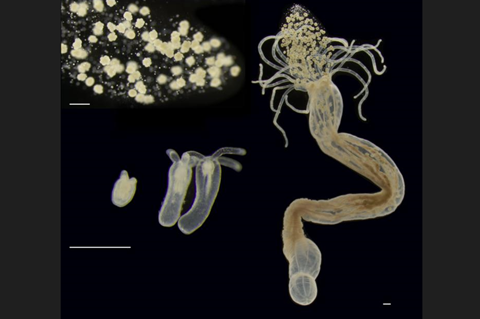The microbiome (the symbiotic community of microbial organisms of a host) is of existential importance for the functioning of every plant and animal, including human beings.

A research team from Düsseldorf and Kiel headed by Heinrich Heine University Düsseldorf (HHU) has used the example of the sea anemone Nematostella vectenis to investigate how the microbiome develops together with the host. In the scientific journal Microbiome, the researchers describe that the bacterial community is primarily controlled by the host organism during the early stages of life, while bacteria-bacteria interactions play the lead role in subsequent development.
Every multicellular living creature – from the simplest organisms to human beings – lives in a community with a multitude of microorganisms, the so-called microbiome. This microbiome comprises bacteria, fungi and viruses among other things and assumes various roles ranging from metabolism to immune defence. For example, without the microbiome in the human intestine, many nutrients could not be absorbed from food and made available to the human body.
Microbiome changes
But how does the microbiome develop as the host develops? It is known that the composition and ratio of the microorganisms in the sea anemone Nematostella vectenis differ fundamentally between the different stages in its life cycle and only assume a stable form in the adult anemone. But who and which factors decide how the microbiome changes as the host matures – does the host control colonisation with the right microbes or do the microbes regulate themselves?
A team from HHU, Kiel University (CAU) and the GEOMAR Helmholtz Centre for Ocean Research Kiel addressed this question. The study was headed by Professor Dr Sebastian Fraune from the Institute of Zoology and Organismic Interactions at HHU. The research was conducted within the framework of the Collaborative Research Centre (CRC) 1182 “Origin and Function of Metaorganisms”, which is headed by CAU.
Dr Hanna Domin, lead author of a study that has now been published in Microbiome, said: “We took adult Nematostella polyps, which had no microbiome following intensive antibiotic treatment, and then recolonised them in a targeted way. To do this, we used bacterial communities that corresponded to those of firstly a Nematostella larva, secondly a juvenile animal and thirdly an adult polyp.”
Initial colonisers
In all three cases, the researchers examined how the microbiome developed over the course of time. They discovered that only the initial colonisers – i.e. the bacteria forming the microbiome of the youngest animals – became really well-established in the adult polyps. By contrast, it was difficult for the bacteria from older animals to become established.
Professor Fraune, corresponding author of the study, added: “Following recolonisation, the microbiome then undergoes a development process that is very similar to the normal development of host and microbiome. It takes around four weeks to reach the same status as adult animals that have undergone a normal growth process.”
The researchers conclude from this that the host – presumably through its innate immune system – controls the composition of the original colony. Domin said: “However, the host no longer has a significant influence over the further development of the microbiome after this point. The bacteria control this themselves and lay suitable foundations for their descendants.”
Metabolic networks
One important aspect of the project, which was driven forward by the research group headed by Professor Dr Christoph Kaleta in Kiel, was the examination of so-called metabolic networks. This involved investigating how the different bacteria are linked via their metabolism and influence each other.
“We were able to identify metabolic pathways, which are specific to the initial colonisers as well as pathways that only play a role at a later stage,” says Dr Johannes Zimmermann from CAU.
The research team established that the degradation of the polysaccharide chitin plays a central role for the initial colonisers in particular. It was only recently discovered that Nematostella can produce chitin. Why the animals do this was however unknown as they for example – by contrast with insects – do not need chitin for their structural development. Fraune said: “Our results provide clear indications that chitin plays a role for the microbiome.”
Innate immune system
The sea anemone only has an innate immune system. Nevertheless, the results are also relevant for medical research. Newborn babies come into contact with numerous bacteria immediately after birth, whereby they also only have an innate immune system at that phase in their lives. Consequently, initial colonisation with the right microbes is also key to establishing a functioning microbiome and training the adaptive immune system in humans.
Fraune said: “It has been noted that the microbiome development of children born by Caesarean section who have only limited contact with the bacterial communities of the mother during birth frequently differs to that of children born naturally.”
However, disrupted microbial colonisation during the early development phase changes metabolic and immune programming, and appears to be connected with an increased risk of immune system and metabolic disorders. For this reason, initial studies are being conducted in which children born by Caesarean section are brought into contact with the vaginal secretions of the mother immediately after birth to ensure natural initial colonisation.







No comments yet